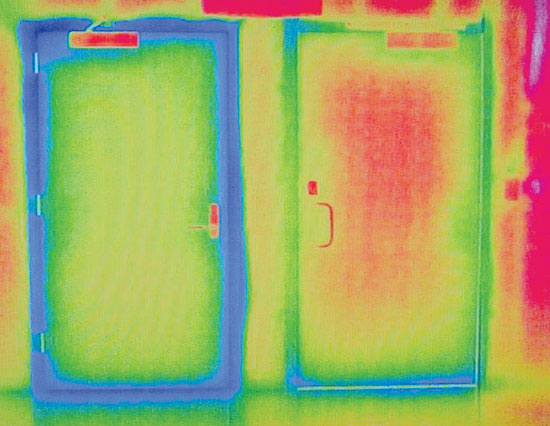Door Opening Solutions in LEED for Healthcare
Air Infiltration Strategies
Unwanted air infiltration dramatically affects the energy performance of a building as much as direct thermal transfer—sometimes even more so. Typically 40 percent of this air infiltration comes from leakage in the building envelope with 11 percent alone identified as coming from exterior doors. The door opening leakage is attributed to small gaps and creases in the areas where the door panels meet the surrounding frame and floor. Left untouched, these gaps allow free passage of air and are a significant source of energy loss.
 |
|
A Kerf door frame allows for reduced air infiltration by allowing for weather stripping and gaskets to be easily and readily installed and maintained. Image courtesy of ASSA ABLOY |
The most effective air sealing strategy around doors is to use gaskets and weatherstripping and door bottoms to create a sealed barrier to control this unwanted air infiltration. Gaskets are commonly used to fill seams around the jambs and door head while a bottom seal and threshold is used to eliminate the gap under the door.
An effective approach to install head and jamb gaskets is to use a kerf frame. These are specially designed frames that feature a groove along the frame section that comes in contact with the door edge. As such, they simplify installation of weatherstripping by serving as a convenient channel to install weatherstripping without using additional fasteners. The grooved kerf frame also means that weatherstripping is easily removable for maintenance or replacement when needed.
Openings with a pair of doors also require gasketing to seal the meeting stile. Gasketing is available in several materials that are flexible and do not impede the operation of the door. They are available in varying grades to meet the conditions of different climate zones. Common products include silicone, santoprene (100 percent recyclable), vinyl, and polypropylene. From an environmental standpoint, chloroprene or neoprene should be avoided. When specifying gasketing, look for products that meet or exceed ANSI 156.22 Door Gasketing and Edge Seal Systems. You should also look for products that show results of ASTM E283 which is the common laboratory testing standard that provides guidelines for air infiltration performance. For field based testing, ASTM E783 is the protocol that is commonly used.
 |
Thermal imaging looking from the interior side of two exterior doors exposed to cold. The door on the left is a traditional door and frame with the blue (cooler temperature) indicating high heat loss. The image on the right is a high-performance door that includes weatherstripping and gaskets with notably warmer interior temperatures and less heat loss around its perimeter. Image courtesy of ASSA ABLOY |
Access Control Strategies
Electronic Access Control (EAC) systems have become very common in many buildings. They provide a degree of building security by limiting and controlling which people can or cannot pass through exterior or interior doors. This is commonly achieved through the use of badges or cards that are inserted or passed by a card reader. While this technology has been a boon to building operations, particularly in healthcare settings, the downside is that they require electricity. Traditionally, these systems included many discreet components which collectively create a larger environmental impact. They require additional wiring, some degree of energy use, more processing and packaging and a 120V outlet with a power supply drawing between 4 – 20 amps at every door to power such things as an access controller, optical request to exit device, and a reader device–all tied back to a power supply and main electronic access control system computer. The good news is that newer lower voltage and extremely energy efficient options are currently available.
An energy-efficient approach for EAC systems is to specify one that integrates all of the traditional components into a single, integrated, door mounted lockset thus eliminating the myriad of parts installed at each door. These integrated, door mounted locksets can then be connected directly to a central access control system or panel using conventional wiring. Generally, these hardwired devices can be expected to use about 15.4 watts at each opening. In existing buildings, or where wiring is not desired, then IP-Enabled WiFi locks can be used. These battery powered devices (on the order of 6 AA household batteries) leverage existing EAC infrastructure to reduce environmental impact even further and completely eliminates the need for any additional wiring or components. The best overall option is to use Power over Ethernet (PoE) locks that can leverage an existing PoE system on an existing computer network to reduce components and minimize energy usage. This type of PoE lock uses a maximum of 7 watts per activation at each lock, 50% less than typical PoE installations. PoE locks also use 85 percent less standby power than traditional access control. Because of their very low energy use, they have been likened to have done to EAC systems what LED bulbs have done to lighting systems.
In terms of energy usage overall, it's important that we look at all parts of the assembly to specify high performance door openings. Insulated core doors, especially sprayed polyurethane, deliver some of the best insulation values. Kerf and Thermal Break frames are a key factor in better U values and air infiltration. Thermally broken thresholds, door bottoms and sweeps along with gasketing are key to performance. Finally, don't forget the importance of specifying high grade hardware, hinges and closers to guarantee the long term performance and durability of the opening.









